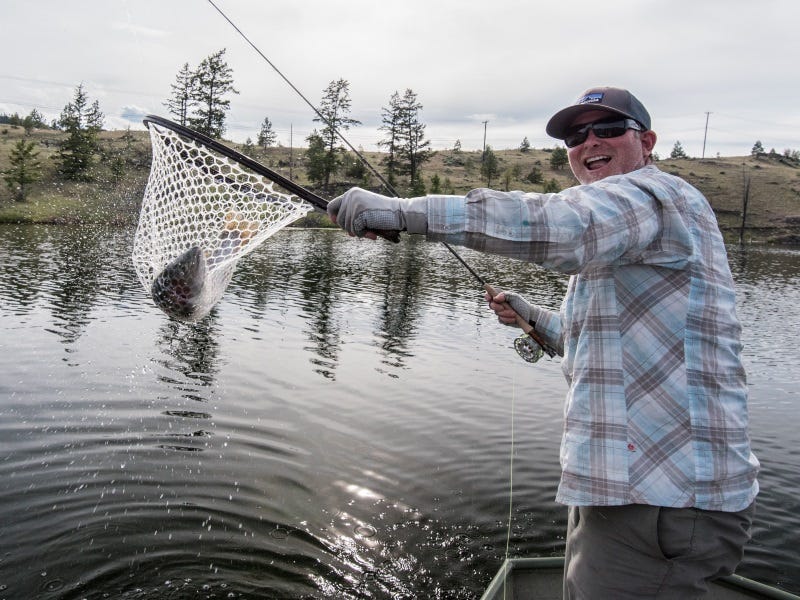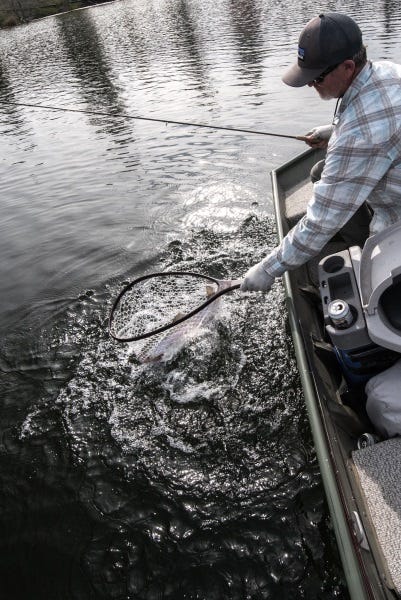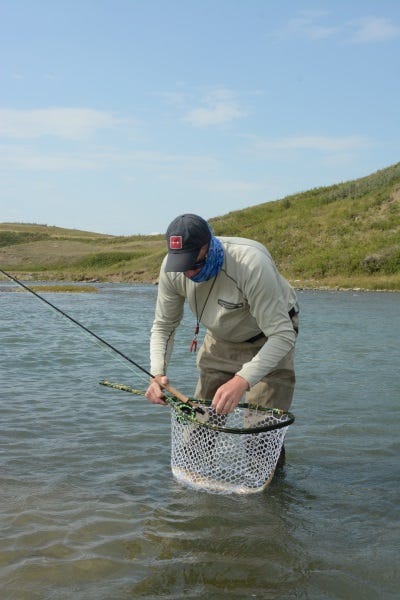Fly-fishing Nets: A buyer’s guide

 Getting a fish in the net is the final piece of your fly-fishing puzzle. Without a net a wild fish might break your tippet at the boat or near the bank. A net diminishes the risk of losing a great catch.
Getting a fish in the net is the final piece of your fly-fishing puzzle. Without a net a wild fish might break your tippet at the boat or near the bank. A net diminishes the risk of losing a great catch.Many times, while rigging up my rod at the truck, I’ve thought, “Ah, I won’t need the net today.” Then I trot down to the river expecting to catch some dinky fish, and out of nowhere Walter (code word for really, really big fish) shows up… probably because I didn’t bring the net.
I know, I know. You think this is a personal problem. And that may be true. But, if you’re a dedicated angler, I bet this has happened to you, too. So hear me out—if you don’t carry a net to the water, you’re just begging for that once-in-a-lifetime fish—Walter—to swim into your life and ruin your day. However, if you have the right net, you stand a good chance of landing that fish and walking away with a lifetime memory—and bragging rights over your buds, too.
Here are some considerations to take into account before buying a new net, or even multiple nets, for various uses.
 When fishing from a boat a long-handled net (not seen here) is a great option. A long handle allows anglers to stand and land a fish, rather than having to kneel in a boat.
When fishing from a boat a long-handled net (not seen here) is a great option. A long handle allows anglers to stand and land a fish, rather than having to kneel in a boat.Size
I consider the size of a net—meaning length and width—as first and foremost in your buying decision. Little fish, big fish, hiking in, drift-boating, pontoon-boating or float-tubing, wading—all are factors in choosing the right size net. If you fish in several of these fashions, you may need two nets. Here’s why: If you are a drift-boater, you may need a long-handled net to reach over a gunwale and down to the water, possibly even beyond an oar blade. These nets aren’t the easiest to store, but they are the ticket when you have to reach for a fish. If you try to land fish from a driftboat with a short handled net, you’ll have to get on your knees to do so. The long handle, in contrast, allows you to stand, and still land a fish. Telescopic nets are an option, too. These nets offer the length you need, and you can reduce the handle and store the net out of the way. Telescopic nets are usually made of aluminum, and they aren’t nearly as pretty as a once-piece wooden boat net, but they help keep the clutter to a minimum.
 A net provides great assistance while removing hooks and photographing fish.
A net provides great assistance while removing hooks and photographing fish.Net bag
This is the second determining factor when considering a net. Note: your dad’s or grandpa’s old net probably won’t do the trick. Why? Because nets and their bags have been upgraded during the past couple decades, with some now offering a rubber coating over nylon or string, or altogether pure rubber mesh. These are cool looking and help protect fish when they are in the net, as rubber is much less abrasive than string or nylon. A fish’s slime is their protection from diseases, so a net bag that is rough, like the old-school green, nylon knotted ones you see for a couple bucks at a general store, can remove this protective layer from fish and potentially harm them. I would steer you away from these nylon nets if you practice catch-and-release. Rubber nets have a drawback as well—rubber net bags are pretty heavy depending on how deep the net is. A deeper bag holds larger fish so you’ll have to consider where you plan to fish and what you plant to fish for when making your decision. If you are after small stream trout, a lightweight, shallow bag should suffice. However, if you are fishing the big tailwaters for big trout, or doubling up on steelhead, salmon and stillwater trout, you may need a deeper bag. Some net bags have built-in measuring tapes, so you can actually tell the truth for once. Some come with a zipper built into the top, so when it comes time to replace the bag, it merely zips off and you zip on a replacement. Pretty handy.
 A fish in a net is much easier to work on—i.e. removing hooks—than one that is being held or resting in the shallows near shore. A synthetic frame net with a rubber bag, like Fishpond’s Nomad (shown here), minimizes damage.
A fish in a net is much easier to work on—i.e. removing hooks—than one that is being held or resting in the shallows near shore. A synthetic frame net with a rubber bag, like Fishpond’s Nomad (shown here), minimizes damage.Frame
Man, there are some amazing hand-built nets out there, made by some incredible craftsmen and craftswomen. They are constructed from all kinds of exotic woods with laminated inlays of different materials. I have one, and it gets on the water with me here and there. But I am always leery about beating it up, so I usually take one of my other nets. I prefer a lightweight frame when walking, wading, and backpacking. However, in the boat I keep a net that is pretty rugged, a bit heavier and more durable. I don’t mind that it is heavier because I’m in my boat and not carrying it. But, as a general rule I think the lighter the better when it comes to choosing a net. Why? Well, when you actually net a fish, the speed with which you can push the net into the water can be determined by the physical weight of the net frame and bag. I spent high school summers in Southeast, Alaska as a deckhand on a charter boat, fishing for halibut and salmon. For the salmon, we had really big long-handled nets. These were problematic because the large net bag would slow the speed we could plunge the net into the water. So my skipper showed me a cool trick to help with this. He tied a piece of parachute cord to the back of the net bag, which was long enough to reach the handle. So you would use the string to pull back the net bag making it much easier to jab into the water. As soon as you got your fish into the net, you released the cord to allow the net bag to come to full size. The mostly solved the problem but again, lighter is better when choosing a net. Another option is a collapsible net that fits into a tube for easy transport through the woods.
Cost
You may ask how much does a good net cost? I suppose cost is subjective and so is your definition of “good.” You can get a good net for around $30-$50. If I had to pick one, I’ll come out at say that I favor the Measure Net, which ranges in price between $32 and $190. This brand has a multitude of different nets, covering the gambit on small-to big with tons of different options, including extendable handles, foam grips, replaceable net bags with zippers, and measuring tapes. They are a well-built net. Fishpond has a good net, too—the Nomad series is super nice and is built with a composite frame, rubber net bag, and a measuring tape on the handle. But don’t think you’re walking out the door with this one for $50. The range on these, depending on size and such, is $125 to $250. When deciding whether paying that price for a net is worth it, remember that a composite frame means this net could be an heirloom piece. In addition, there are quite a few custom net builders who can build you a wooden net that is also “heirloom quality.” As you might expect, you’ll pay for that attention to detail but you’ll also pull out a piece of art to admire, every time you land a fish.
